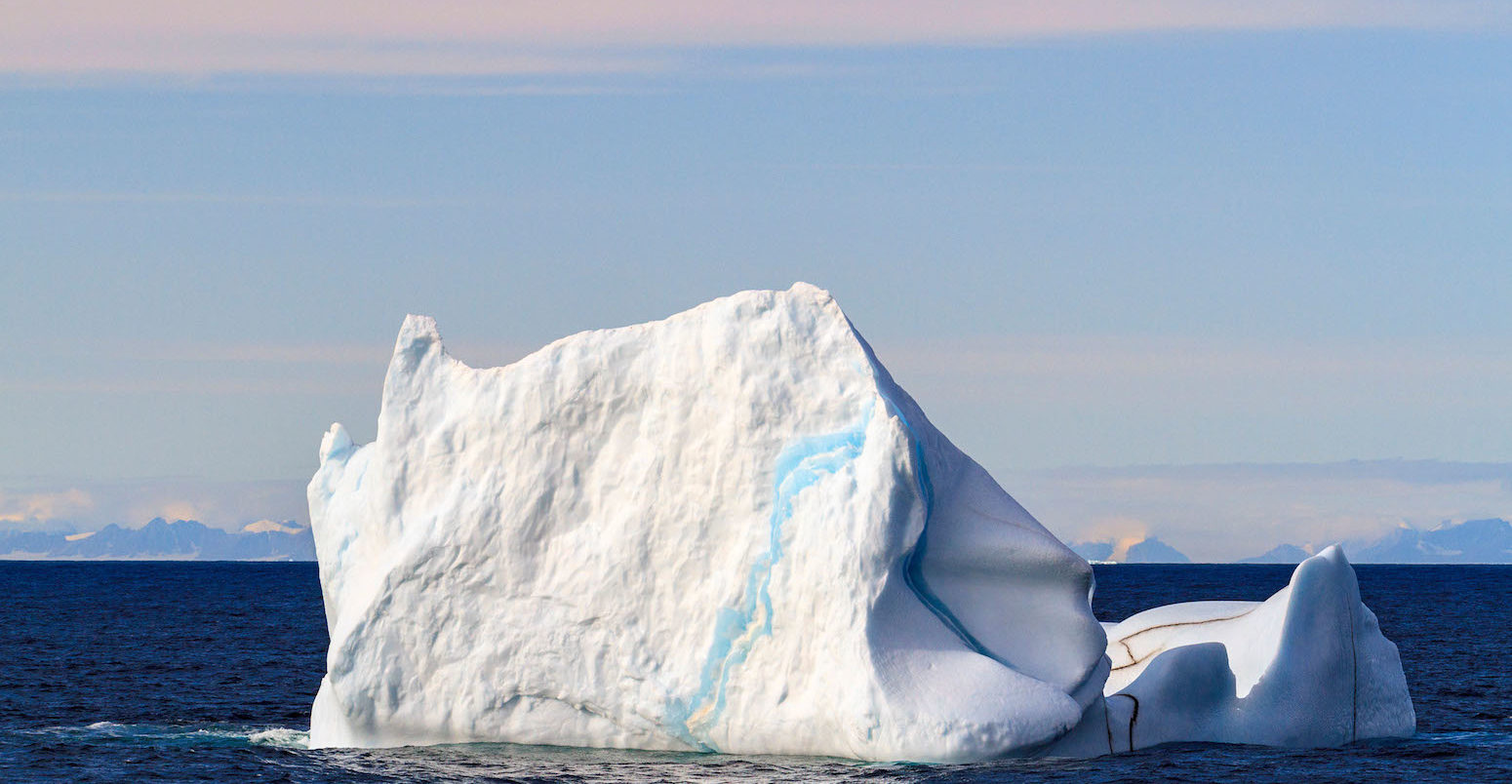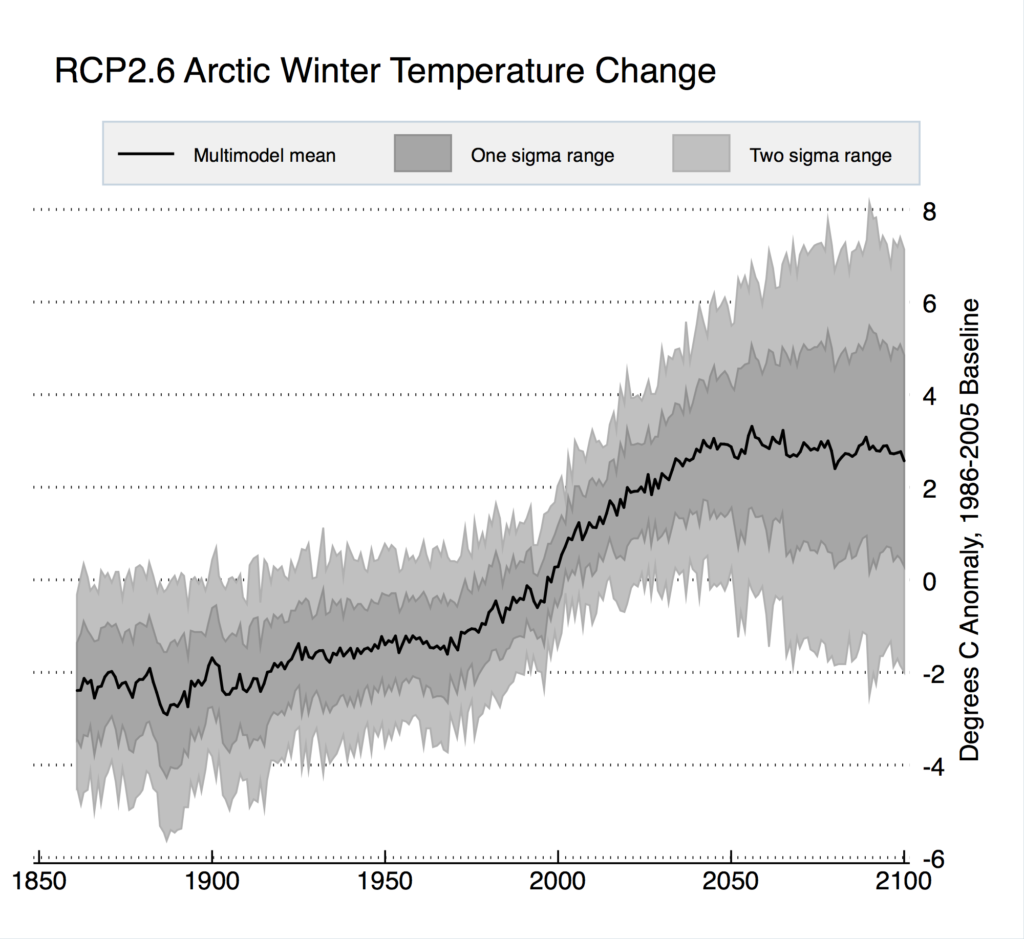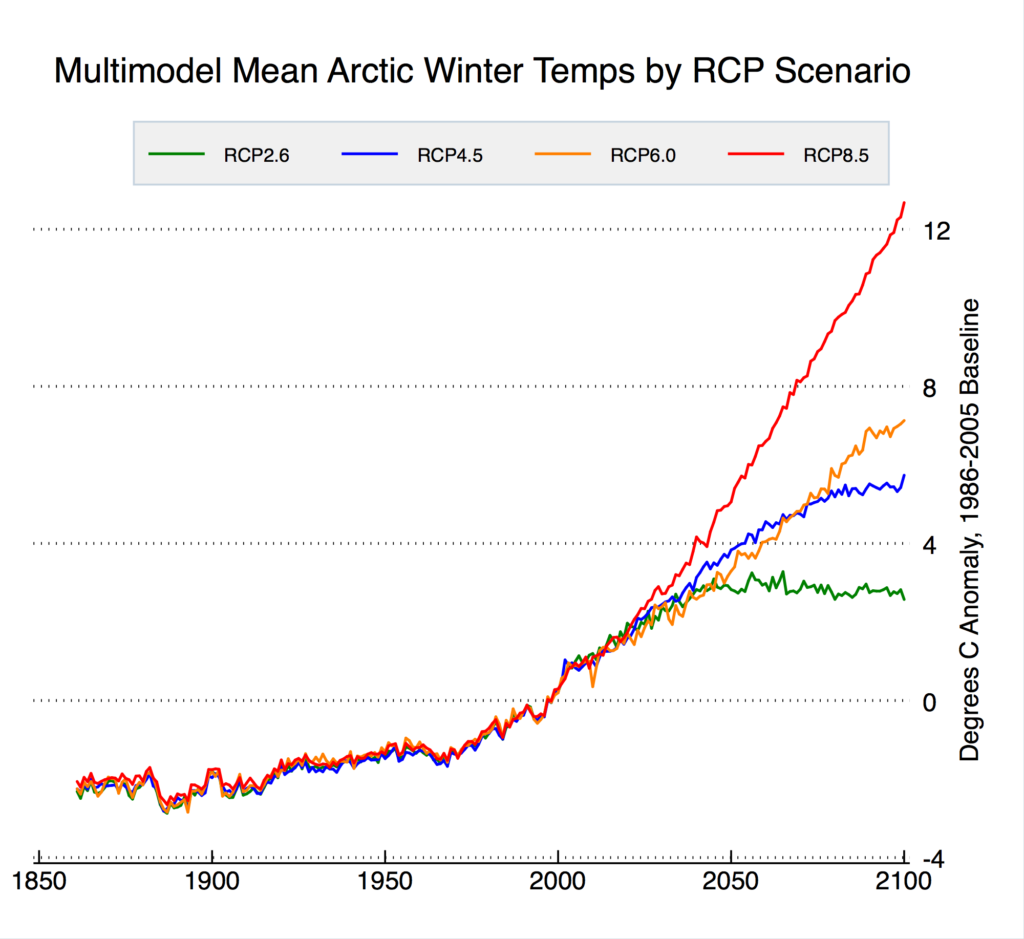
Factcheck: Is 3-5C of Arctic warming now ‘locked in’?
Zeke Hausfather
03.16.19Update – 22 March 2019: In response to this factcheck and feedback from other experts, both the UN Environment report and press release have been updated to correct the issues raised. The original factcheck is available for reference below.
A new UN Environment report on the Arctic was released last week, which covered a broad range of changes to the region’s climate, environment, wildlife and epidemiology.
The accompanying press release focused on the report’s section about climate change. It warned that, “even if the Paris Agreement goals are met, Arctic winter temperatures will increase 3-5C by 2050 compared to 1986-2005 levels” and will warm 5-9C by 2080.
The report was covered by a number of news outlets, including the Guardian, Wired, Hill, CBC and others. Media coverage focused on the idea – promoted in the press release – that large amounts of Arctic warming is “locked in”, “inevitable” or “unavoidable”.
However, an investigation by Carbon Brief has found that the section of the report on climate change erroneously conflates the Paris Agreement target – which is to limit warming to “well below” 2C by the end of the century relative to pre-industrial levels – with a scenario that has much more modest emission reductions which result in around 3C of global warming.
In climate-model runs using a scenario limiting global warming to below 2C, the Arctic still warms faster than the rest of the world. But future Arctic winter warming will be around 0.5-5C by the 2080s compared to 1986-2005 levels, much lower than the 5-9C values stated in the report.
This means that much of the future warming in the Arctic will depend on our emissions over the 21st century, rather than being “locked in”, as the report claims.
Erroneous paragraph
The UN Environment report is titled, “Global linkages: A graphic look at the changing Arctic”. It provides a brief, accessible and infographic-heavy look at a number of different areas in which the Arctic has changed in recent decades and may change in the future.
The section of the report covering Arctic temperatures – which is only two pages long – does not present any new research. Rather, it summarises the findings of a number of recent, more technical studies. The future temperature projections, which were the focus of the press release and associated media coverage, are contained in a single paragraph of the report:
“Warmer temperatures in the Arctic resulted in a record low in the winter sea ice extent between 2015–2018 (Overland et al., 2018). Indeed, under a medium- or high-emission scenario, projected temperature changes for the Arctic will follow a winter warming trend at least double the rate for the northern hemisphere (AMAP 2017a). This means that even if countries manage to cut GHG emissions to the targets outlined in the 2015 Paris Agreement on climate change, winter temperatures in the Arctic will still be 3 to 5C higher by 2050 and 5 to 9C higher by 2080, relative to 1986–2005 levels. In fact, even if we stopped all emissions overnight, winter temperatures in the Arctic will still increase by 4 to 5C compared to the late twentieth century. This increase is locked into the climate system by GHGs already emitted and ocean heat storage (AMAP 2017a).”
However, this paragraph contains a number of unclear statements and errors that undercut the message that large amounts of future Arctic warming are “locked into the climate system”.
While the first two sentences are accurate, problems begin in the third when the report argues that meeting Paris Agreement targets would still result in winter Arctic warming of 3-5C by 2050 and 5-9C by 2080, relative to 1986-2005 levels.
The reference for these numbers is the 2017 Arctic Monitoring and Assessment Programme (AMAP) report. The 2017 AMAP report states:
“Over the Arctic Ocean, which is ice-free in early winter in some models and covered by thin sea ice during late winter, the warming is 3–5C by mid-century and 5–9C by late century under RCP4.5.”
![]()
The UN Environment report drops the reference to the Arctic Ocean, referring to these warming projections as ”winter temperatures in the Arctic” – a much larger area of the Earth than just the region over the Arctic Ocean. The actual warming in RCP4.5 for the full Arctic (between 60N and 90N) in the 2017 AMAP report is a bit lower: around 3.8-7.8C in the 2080s. There is another minor issue where the new report gives specific years (2050 and 2080), while the 2017 AMAP report actually uses the periods from 2050-2059 and 2080-2089.
The major problem with the paragraph comes when it associates the 2017 AMAP warming numbers – which refer to the RCP4.5 scenario – with “the targets outlined in the 2015 Paris Agreement on climate change”.
![]()
In the Paris Agreement, countries set a target to limit warming “well below” 2C, with an aspirational target of limiting warming below 1.5C. However, the 2017 AMAP report only considers two future emissions scenarios: a very-high-emission RCP8.5 scenario, where the world experiences more than 4C warming; and a medium-emission RCP4.5 scenario, where the world experiences around 3C warming compared to pre-industrial levels by the end of the century.
If countries were to meet the Paris Agreement target of limiting warming to “well below” 2C, global emissions would actually follow a RCP2.6 scenario (or cut emissions even more quickly to limit warming to 1.5C). While RCP2.6 still sees some additional Arctic warming, it is much smaller than the numbers contained in the report.
The figure below shows the winter warming in the Arctic from all of the CMIP5 climate models used in the Intergovernmental Panel on Climate Change (IPCC) fifth assessment report for the RCP2.6 scenario. The black lines show the average of all the models, the dark area shows the range in which two-thirds of the models fall (the one-sigma range), and the light area shows the range covering 95% of the model runs (the two-sigma range).

RCP2.6 climate-model runs from CMIP5 for the region between 60N and 90N for the winter months (December, January and February) for the 32 different climate models providing RCP2.6 runs (with one run used per model). Model data obtained from KNMI Climate Explorer.
In a scenario where the Paris Agreement target is met, the actual winter warming projected for the Arctic is 0.8-4.5C in the 2050s and 0.5-5C in the 2080s relative to 1986–2005 levels (following the approach used in 2017 AMAP report of giving one-sigma ranges). The multi-model mean shows 2.8C warming in both the 2050s and 2080s, as falling global emissions limit further warming after the middle of the century.
The statement in the report that “even if we stopped all emissions overnight, winter temperatures in the Arctic will still increase by 4C to 5C compared to the late twentieth century” is puzzling, as it does not appear anywhere in the 2017 AMAP report that it cites.
Confusingly, the UN Environment report is claiming that cutting emissions to zero immediately would lead to more warming than occurs in climate models running the RCP2.6 scenario – a scenario which only has emissions reaching zero by around 2080. Carbon Brief reached out to a number of climate scientists, all of whom expressed puzzlement as to what might provide the basis of this claim. Carbon Brief asked UN Environment and the report’s authors for a response, but did not receive one before publication. (This article will be updated to include any response.)
According to an analysis featured in the recent IPCC special report on 1.5C, reducing all human emissions of greenhouse gases and aerosols to zero immediately would result in a modest short-term bump in global temperatures of around 0.15C as Earth-cooling aerosols disappear, followed by a decline. Around 20 years after emissions went to zero, global temperatures would fall back down below today’s levels and then cool by around 0.25C by 2100. While reducing aerosols might have a larger warming impact in the Arctic than other regions, an additional long-term warming of 4C to 5C seems rather unlikely.
Not ‘locked in’
Why might the report conflate a 3C global-warming scenario (RCP4.5) with the Paris Agreement target (RCP2.6)? The actual commitments made by countries in the Paris Agreement – the nationally determined contributions (NDCs) – fall well short of what would be needed to meet the Paris target. If countries only take these actions – and do not ratchet up their commitments after the Paris commitment period ends in 2030 – studies suggest that the world would be on track for a bit more than 3C warming, though how much depends largely on assumptions around emissions between 2030 and 2100.
However, even if the report meant to say “the warming implied by existing Paris commitments” rather than the “Paris targets”, the press release and subsequent media coverage are still misleading. Unless the authors are arguing that the world as a whole is already locked into 3C warming – and there are plenty of scenarios that would keep global warming below 2C, or even down to 1.5C warming – the amount of future warming that will occur in the Arctic during the 21st century will depend in large part on our future emissions.
The figure below shows the winter Arctic warming relative to 1986-2005 from the average of all the IPCC CMIP5 climate models for each future RCP emission scenario. There is a wide range of potential future warming, from as little as 2.7C in 2100 in RCP2.6 to as much as 12C in RCP8.5. Which of these future warming scenarios will occur depends largely on our greenhouse gas emissions over the rest of the 21st century.

CMIP5 Multimodel mean for each RCP scenario for the region between 60N and 90N for the winter months (December, January and February). Model data obtained from KNMI Climate Explorer.
If the world actually meets the Paris target of limiting warming below 2C, the future Arctic winter warming will be around 0.5-5C, much lower than the 5-9C values stated in the report.
There is still a wide range of possible outcomes for the region. As a result, any claim that massive amounts of future warming for the region are “locked in” is misleading.

